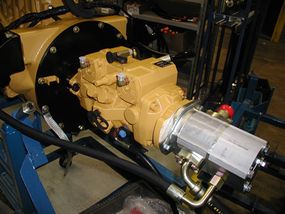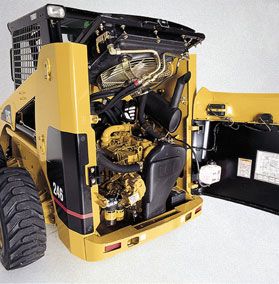The Powertrain
In your car, the main parts of the powertrain are the engine and transmission. In a skid steer loader, the powertrain consists of a diesel engine and a set of hydraulic pumps.
The Engine
Why do a skid steer loader and multi terrain loader use a diesel engine? For the same reason that all construction, mining and farm equipment does: Diesel engines are more efficient than gasoline engines. A skid steer loader or multi terrain loader may operate eight or more hours every day. Over the course of a year, a 5 or 10 percent difference in efficiency can make a real difference in fuel costs.
Advertisement
Although the engine, cooling system and other accessories are tightly packed into the skid steer loader, the engine compartment is designed to make maintenance easy. A door on the back opens wide, and the radiator and fan tilt up to allow clear access to the engine and all of the maintenance items (such as filters).
The engines in the Caterpillar Skid Steer Loaders and Multi Terrain Loaders range from a 49-horsepower (37-kilowatt), naturally aspirated diesel engine to a 74-hp (55-kW), turbocharged diesel engine. This power is transmitted to a set of hydraulic pumps bolted directly to the output of the engine.
The Pumps
There are a total of four hydraulic pumps hooked up to the engine:
- Two variable-displacement pumps located in a single housing provide hydraulic power for the two hydraulic drive motors.
- A fixed-displacement pump provides hydraulic power for the loader arms and accessories.
- A smaller fixed-displacement pump provides hydraulic power for circulating the hydraulic fluid through filters, and provides pressure to the pilot controls.

This setup allows the skid steer loader to make good utilization of the engine's power without ever stalling it. An engine stalls when the load on it is greater than the power it can produce. On hydraulic machines like these, the power that the engine can produce has to be balanced with the power that the hydraulic system uses. The maximum amount of power that the engine can make depends on the speed it's running at. On a skid steer loader or multi terrain loader, an engine at full speed can produce its top rated horsepower.
Between the pumps that power the wheels and the pump that powers the work tools, the hydraulic system can demand more power from the engine than the engine can generate. The system is designed this way so the operator can apply the full power of the engine to either the wheels or the implements at any given time. On most skid steer loaders, it is up to the operator to carefully modulate the controls to keep the engine from stalling (which requires skill and practice). On Caterpillar Skid Steer Loaders, the operator doesn't have to worry about stalling the engine -- the machine makes sure this doesn't happen.
The power used by a hydraulic pump is equal to its pressure multiplied by the flow rate of its fluid. On the Caterpillar machines, the implement pump is a fixed-displacement pump. In this type of pump, the flow rate is determined by the pump's speed (which is equal to the speed of the engine) and its displacement (the volume of the cylinders in the pump). The faster a given pump spins, the higher the flow rate. The pressure is determined by the tasks the operator is performing. For instance, the pressure is high when the operator is digging a bucket of dirt out of a pile, and it is low when he tilts the bucket to dump the load.
This pump is designed so that at its maximum pressure and flow rate, it does not stall the engine. But, if the hydraulic pumps that drive the wheels were to draw any power while the implement pump is at maximum pressure and flow, the engine could stall. This is why the pumps for the wheels are variable-displacement pumps.
When the operator is not using an implement, the pumps can operate at their maximum displacement, using the full power of the engine to drive the wheels or tracks. The speed of the machine is determined by the flow rate of fluid from the pumps, while the torque is determined by the pressure.
During an operation like loading a pile of dirt into a truck, the operator uses a lot of the engine power to push the machine into the pile. When the operator lifts a bucket load of dirt out, it takes a lot of force to break the load out of the pile. If the implement pump were to supply the pressure and flow for this operation while the drive pumps were still drawing power, the engine would stall.
When the skid steer loader or multi terrain loader enters the pile, the wheels use more power; then, as the operator starts to lift, the hydraulics take most of the engine's power to break the bucket out of the pile.
To avoid this, the Caterpillar machines automatically reduce the displacement of the pumps. This keeps the engine from stalling while still maintaining torque to the wheels or tracks at a reduced speed.
Now let's take a look at the loader arms, where we'll see some really good engineering.
